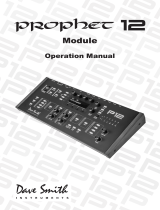
x
A Few Words of Thanks
Thank you for purchasing the Prophet X. The Prophet X is a powerful evolution of
the Prophet series. We’ve added a new sound engine with sample playback, which
gives you all of the synthesis capabilities and great sound you’d expect from a
Prophet, but now with the innite possibilities of samples. What’s more, the new
analog lter design in the Prophet X is not only fantastic for synth sounds, but
does something special for the sampled instruments as well.
As a whole, the Prophet X covers more musical ground than any Prophet we’ve
ever created. Composers will love it for soundtracks, synth geeks will love it for
sound mangling, live players will love it for its versatility, and we love it because
its just an awesome synth.
Make some great sounds with it!
Cheers,
THE SEQUENTIAL CREW
Art Arellano, Fabien Cesari, Bob Coover, Carson Day, Chris Hector, Tony Karavidas, Mark Kono,
Justin Labrecque, Andy Lambert, Michelle Marshall, Andrew McGowan, Joanne McGowan,
Julio Ortiz, Campbell Smith, Tracy Wadley, and Mark Wilcox.
THE 8DIO CREW
Troels Folmann, Cam Goold, Alejandro Cabrera, Colin Fisher, and Tawnia Knox.
THE SOUND DESIGN TEAM
Richard Devine, Rory Dow, Peter Dyer, Mike Hiegemann, Tim Koon, Kurt Kurasaki, Kevin Lamb,
Drew Neumann, Bob Oxley, Francis Preve, Robert Rich, Lorenz Rhode, Matia Simovich,
Huston Singletary, James Terris, Mitch Thomas, and Taiho Yamada.
Special thanks to Robert Rich for the alternative tunings content.
LICENSE AGREEMENT
By purchasing Sequential Prophet X, you accept the following product license agreement with
respect to the “Samples by 8Dio” sample elements thereof and/or incorporated therein (“Samples”):
1. License Grant:
The Samples in Sequential Prophet X are licensed, but not sold, to you by 8Dio, Inc. for commer-
cial and non-commercial use in music, sound-effect, audio/video post-production, performance,
broadcast or similar nished content-creation and production use. 8Dio allows you to use any of the
Samples for commercial recordings without paying any additional license fees or providing source
attribution to 8Dio, Inc.
This license expressly forbids any inclusion of the Samples into any other hardware device or in any
virtual instrument or library of any kind, without our express written consent. This license forbids
any re-distribution method of any of the Samples by means of re-sampling, mixing, processing,
isolating, or embedding into software or hardware of any kind, for the purpose of re-recording or
reproduction as part of any free or commercial library of musical and/or sound effect samples and/or
articulations, or any form of musical sample or sound effect sample playback system or device or on
a stand-alone basis.
2. Rights/Watermarking Policy:
The Samples, including accompanying documentation, are protected by copyright laws and inter-
national copyright treaties, as well as other intellectual property laws and treaties. 8Dio retains full
copyright privileges and complete ownership of all recorded sounds, instrument programming, docu-
mentation and musical performances included in Sequential Prophet X. Any rights not specically
granted herein are reserved by 8Dio.
Any unauthorized use, distribution or reproduction of the Samples shall not be permitted, shall con-
stitute a violation of law, and shall entitle 8Dio to, in addition to any other remedy at law or equity,
injunctive relief. It is unlawful to deliberately circumvent, alter or delete technological measures of
protection and information provided by 8Dio which identies the products, its owner and the terms
and conditions for its use. Please note that the Samples may be imbedded with a digital watermark.
If the product ends up in other people’s music, you will be held legally responsible, so we ask you
to not to violate the terms of this license agreement. You further agree to take all reasonable steps to
protect this product from unauthorized copying or use.






















